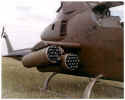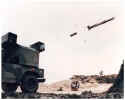1987
FY 87 The Flight Operations Division was redesignated the Flight Operations Directorate as part of RASA's compliance with the Army's Standard Installation Organization (SIO) structure.

1 January 87 As mandated by Congress, the MICOM Civilian Pay Section implemented the new Federal Employee Retirement System (FERS), which consisted of three parts: a basic benefit plan, Social Security, and the Thrift Savings Plan (TSP). Employees hired after 1 January 87 were automatically covered under the new system. Those hired before 1 January 87 had a one-time opportunity to either choose the new system or remain under the old Civilian Service Retirement System (CSRS).
April 87 The governments of Sweden and the United States signed the production supplement to the 4 April 86 MOU providing for the development of the Swedish GLH.
1 April 87 The Secretary of the Army and the Army Chief of Staff expanded the Model Installation Program (MIP) initiative Army-wide. The program provided commanders and managers the opportunity to test innovative ideas, remove regulatory delays, and challenge Army systems and techniques used to manage Army installations.
2 April 87 The Army granted the AT-4 an unconditional release.
2 April 87 The Deputy Division Chief of Procurement Division "D" received the Frank S. Besson Memorial Award for Procurement Excellence in recognition of the division's successful obligation in FY 86 of 98.3 percent of carryover funds for repair parts.
13 April 87 The MICOM Commander accepted AMCCOM's proposed transition plan for the HYDRA 70 components still being managed at Redstone Arsenal.

15 April 87 The TOW Project Office approved the TOW 2A Missile Integration Implementation engineering change proposal (ECP), thereby establishing a new missile configuration for the U.S. Army. Production of the TOW 2A began this same month.
21 April 87 The 82d Airborne Division, Fort Bragg, North Carolina, was the first unit to be equipped with the AT-4, achieving IOC.
27 April 87 Fielding of the first HAWK battalion with the New Mexico ARNG began.
May 87 The Redstone Arsenal Golf Club allowed eligible civilians to use its facilities on a restricted basis.

1 May 87 The first four Program Executive Offices (PEOs) at Redstone Arsenal were established. These included the Forward Area Air Defense (FAAD), Close Combat Missiles, Fire Support, and High-Medium Air Defense (HIMAD) PEOs. This action marked a major change in the organization of the project management offices that involved a restructuring of the Army's acquisition process. The PEO concept was envisioned as a "partnership" effort between the PEOs/PMs and the MSCs providing functional personnel and facilities, with the Army Acquisition Executive (AAE) and the PEOs retaining approval authority for all programmatic issues.
26 May 87 The RD&E Center's Fiber Optic Guided Missile (FOG-M) Project Office was redesignated the Non-Line of Sight (NLOS) Project Management Office (Provisional) and established as a separate organization by MICOM Permanent Orders 74-5. The FOG-M was a self-contained munition thrust project to demonstrate the use of fiber optic guidance of a missile in the attack of high-value point targets with indirect fire from defilade positions.
June 87 Delivery was made of the last Basic STINGER missiles in support of an FMS case with Italy. Basic STINGER production was completed.
June 87 The BFVS/T2SS and TOW 2 subsystem support equipment (T2SS-SE) were approved for release to TRADOC.
30 June 87 PAD implemented MICOM's first Contractor Performance Certification Program (CP)2. This new AMC quality control program not only made the contractor responsible for the materiel it produced for the Army, but also reduced government oversight in the plant. Because of its track record and managerial commitment to quality, MICOM chose the Raytheon Company in Andover, Massachusetts, as its first (CP)2 contractor.
July 87 Testing and evaluation of the three candidate PMS systems was completed.
9 July 87 Management responsibility for the AT-4 Swedish Recoilless Rifle transitioned to AMCCOM.
August 87 MICOM awarded the first production contract for ATAS launchers.
24 August 87 Boeing Aerospace Corporation was awarded a contract for production of its AVENGER/PMS weapon system.
17 September 87 The MICOM Commander approved the full materiel release of the STINGER-POST.

30 September 87 MICOM's Personnel, Training, and Force Development (PT&FD) Directorate was redesignated the Personnel and Training Directorate (P&TD) after its Force Development Division became part of the Resource Management Directorate (RMD). CPO transferred intact to P&TD, becoming one of two divisions within the reorganized directorate.
October 87 The United States and the Ministry of National Defense of the Republic of Turkey signed an MOU authorizing Turkey to coproduce selected MLRS major items.
1 October 87 To comply with AMC's Organizational Standardization of Major Subordinate Commands, the MICOM Comptroller's Office was restructured internally and redesignated as the Resource Management Directorate effective this date.
1 October 87 The VIPER Project Office was officially redesignated the AAWS Project Office. MICOM formally requested the name change, because the organization's original name no longer reflected the mission of the project office.
12 November 87 The ribbon-cutting ceremony for Redstone Arsenal's new Child Development Center was held. One of the Army's first child development centers completed using the developmental modular system, the new facility accommodated 191 children and serviced both active duty and retired military family members.

17 November 87 The contract for the U.S. GLH, being developed for the 9th ID, Fort Lewis, was awarded to Rockwell International Corporation.
20 November 87 The Post Gym was renamed Pagano Gym in honor of CPT Barbara Pagano, former commander of the 95th Maintenance Company.
December 87 Fielding of an MLRS battalion to positioning of materiel configured to unit sets (POMCUS) stockages began with the deployment of Headquarters, Headquarters and Service Battery, A Battery, and B Battery, 16th Combat Equipment Company.
Redstone Arsenal Era:
Intro,
1980,
1981,
1982,
1983,
1984,
1985,
1986,
1987,
1988,
1989
